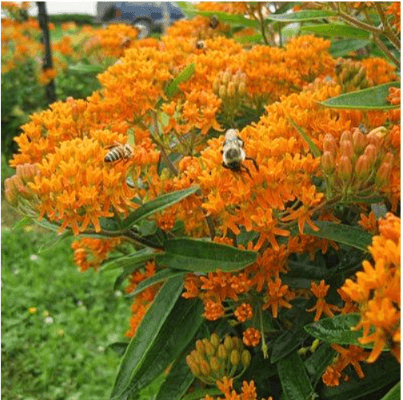The iconic monarch butterfly, with its vibrant orange wings and intricate black veins, has long captivated the hearts of nature enthusiasts. Yet, this majestic insect has faced a problematic decline in recent decades, hovering on the brink of endangerment. Habitat loss, climate change, pesticide use, and other human activities contributed to the monarch’s dwindling population. However, amidst these challenges, a glimmer of hope emerges in the form of pollinator plants. Among these, milkweed plants, butterfly plants, and perennials stand out as crucial allies in the fight to save the monarch butterfly. This essay explores how these plants are playing a pivotal role in reviving the monarch population from the brink of extinction.
Milkweed Plants: A Vital Host for Monarch Caterpillars
At the heart of the monarch’s life cycle lies the milkweed plant(genus Asclepias Incarnata). Milkweed serves as the primary host plant for monarch caterpillars, providing essential nutrients and protection during their larval stage. Monarch females carefully select milkweed leaves on which to deposit their eggs, ensuring the next generation’s survival. As the caterpillars hatch, they voraciously consume the milkweed foliage, accumulating toxins known as cardenolides that render them unpalatable to predators.
However, widespread herbicides and urbanization have decimated milkweed populations across North America, depriving monarchs of critical breeding grounds. Recognizing the situation’s urgency, conservationists and gardeners have rallied to restore milkweed habitats. By planting native milkweed species in gardens, parks, and other green spaces, they create vital refuges for monarchs to reproduce and thrive.

Butterfly Plants: Nectar-rich Havens for Adult Monarchs
While milkweed sustains monarch caterpillars, adult butterflies rely on nectar-rich flowers to fuel their journeys across vast distances. Butterfly plants,also known as nectar plants, are crucial in providing sustenance for monarchs during their migratory flights. These plants encompass diverse species, including coneflowers, black-eyed Susans, and asters, each boasting colorful blooms that beckon to pollinators.
By cultivating butterfly-friendly gardens abundant with these floral treasures, individuals can create vital rest stops for migrating monarchs. These gardens support monarchs and contribute to the conservation of other pollinators, such as bees and butterflies, fostering biodiversity and ecological resilience.

Perennials: Sustainable Support for Monarch Habitats
In the face of climate change and habitat fragmentation, establishing resilient ecosystems is paramount to the monarch’s survival. With their ability to endure seasonal fluctuations and persist year after year, Perennials offer a sustainable solution to bolstering monarch habitats. Unlike annual plants that require replanting each season, perennials form stable foundations for monarch-friendly landscapes, requiring less maintenance and resources over time.
Native perennial species, such as goldenrods, milkweeds, and native grasses, are particularly well-suited for supporting monarchs and other pollinators. Their deep root systems enhance soil stability, mitigate erosion, and provide habitat for diverse organisms. By incorporating perennials into conservation efforts, communities can create lasting sanctuaries for monarchs to weather the challenges of a changing environment.
Community Engagement and Conservation Initiatives
The restoration of monarch habitats hinges not only on the actions of individuals but also on collective efforts orchestrated by communities, organizations, and governments. Across North America, a groundswell of conservation initiatives has emerged to address the monarch butterfly’s plight. These efforts encompass a spectrum of activities, from community-led habitat restoration projects to large-scale policy interventions aimed at conserving critical monarch breeding and overwintering sites.
One notable example is the Monarch Joint Venture, a partnership of federal and state agencies, non-governmental organizations, and academic institutions dedicated to monarch conservation. The Monarch Joint Venture seeks to safeguard monarch populations and their migratory phenomenon for future generations through collaborative research, outreach, and habitat restoration.
Furthermore, citizen science initiatives, such as Journey North and the Monarch Larva Monitoring Project, empower volunteers to contribute valuable data on monarch sightings, migrations, and breeding habitats. By engaging citizens in scientific research and environmental stewardship, these programs foster a sense of ownership and connection to monarch conservation efforts.
Conclusion:
In the face of mounting threats, pollinator plants emerge as beacons of hope for the beleaguered monarch butterfly. Milkweed plants, butterfly plants, and perennials serve as cornerstones of monarch conservation, providing essential resources and habitats for all stages of the butterfly’s life cycle. Through concerted action at the individual, community, and societal levels, we can reverse the monarch’s decline and ensure that future generations continue to marvel at the sight of these magnificent creatures gracing our skies. By embracing the power of pollinator plants, we embark on a journey to save a species and preserve the intricate tapestry of life that sustains us all.


